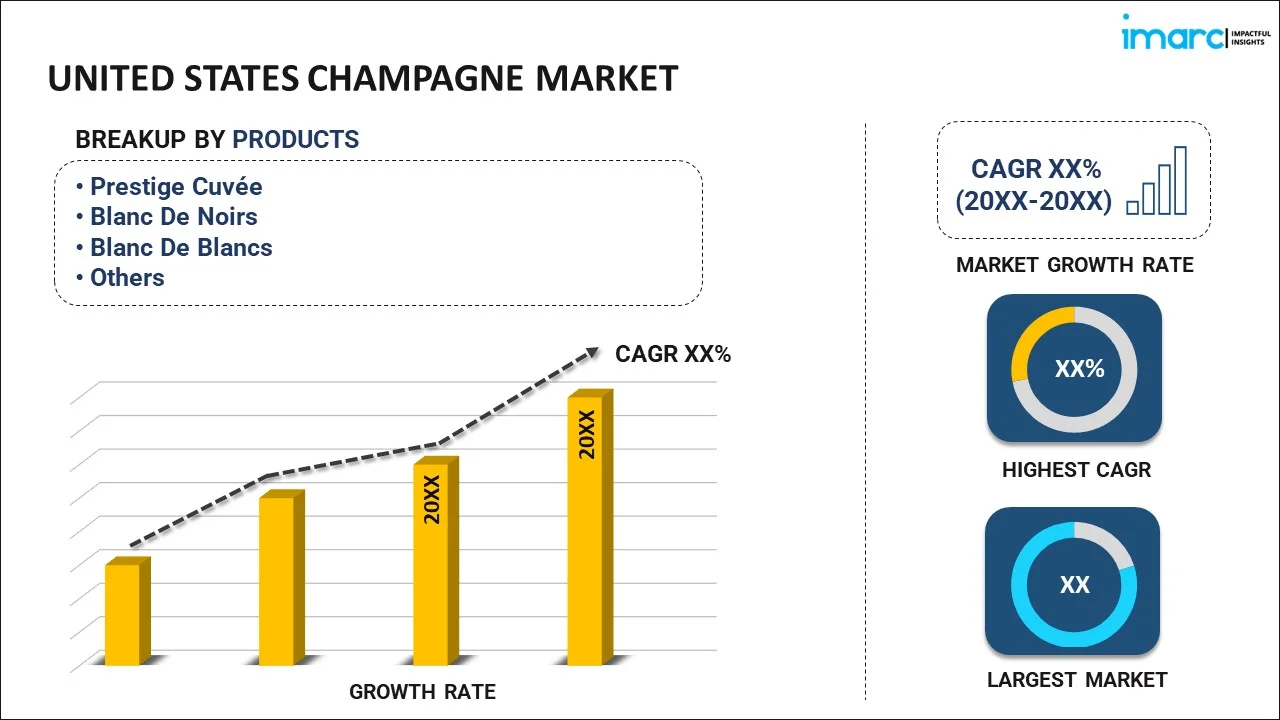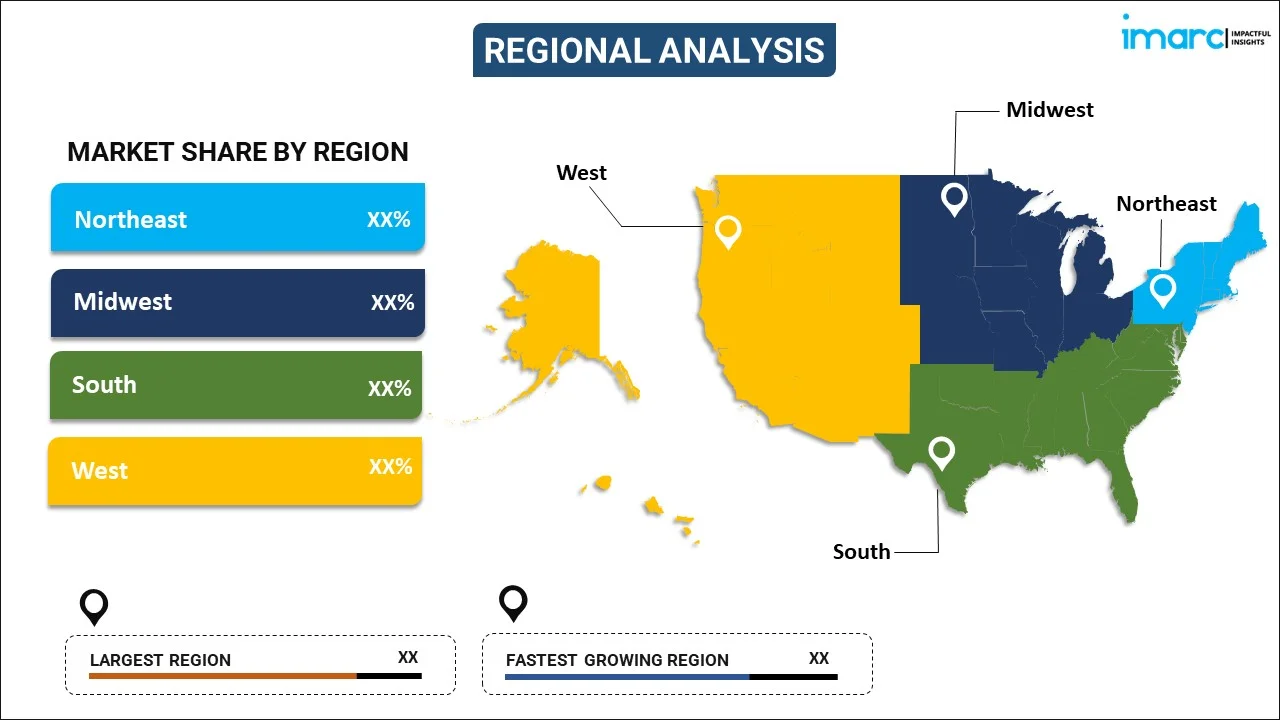
United States Champagne Market Report by Product (Prestige Cuvée, Blanc De Noirs, Blanc De Blancs, Rosé Champagne, and Others), Price (Economy, Mid-Range, Luxury), Distribution Channel (Supermarket and Hypermarket, Specialty Stores, Online Stores), and Region 2025-2033
Market Overview:
The United States champagne market size reached USD 1.7 Billion in 2024. Looking forward, IMARC Group expects the market to reach USD 2.4 Billion by 2033, exhibiting a growth rate (CAGR) of 4.2% during 2025-2033. The increasing demand for premium quality champagne products, changing consumer preferences, rising disposable income, the growing popularity of social media platforms, and widespread adoption of champagne in anniversaries, events, and birthdays represent some of the key factors driving the market.
|
Report Attribute
|
Key Statistics
|
|---|---|
|
Base Year
|
2024 |
|
Forecast Years
|
2025-2033 |
|
Historical Years
|
2019-2024
|
| Market Size in 2024 | USD 1.7 Billion |
| Market Forecast in 2033 | USD 2.4 Billion |
| Market Growth Rate (2025-2033) | 4.2% |
Champagne is a sparkling wine that is renowned for its elegance, quality, and association with celebration. It is produced through a specific winemaking method known as the method champenoise or traditional method. It is produced primarily from three grape varieties such as Chardonnay, Pinot Noir, and Pinot Meunier which contribute unique characteristics to the final blend. Chardonnay provides freshness, finesse, and citrus flavors, while Pinot Noir adds body, structure, and red fruit notes. On the other hand, Pinot Meunier contributes a fruity and approachable quality to the wine. It is often associated with special occasions and is a popular choice for toasting and celebrations and has a reputation for luxury and is considered a symbol of prestige and refinement. The production process of champagne involves two fermentation stages. Initially, the base wine is created through the first fermentation, which converts grape juice into still wine. Then, a second fermentation occurs inside the bottle, wherein a mixture of yeast and sugar, known as the liqueur de tirage, is added to the base wine, causing a secondary fermentation that produces carbon dioxide, resulting in characteristic bubbles. The wine ages on its lees, developing complex flavors and aromas before the sediment is removed through a process called disgorgement. As a result, champagne with its effervescence, delicate flavors, and unique production process is gaining immense popularity across the globe.
United States Champagne Market Trends:
The market is primarily driven by the changing consumer preferences and evolving lifestyles of consumers. As people seek to elevate their experiences and indulge in luxury, champagne has become a symbol of sophistication and prestige. In addition, the rising disposable incomes and increasing consumer willingness to spend on premium products are escalating demand for champagne. It is a preferred choice for celebrations and special occasions among consumers which is influencing the market growth. Moreover, the expanding culture of socializing and gifting has significantly impacted the champagne market. Also, champagne is often associated with toasting and commemorating memorable moments, making it an ideal gift for birthdays, anniversaries, and corporate events propelling the market growth. The act of presenting champagne as a gift has become a gesture of appreciation and sophistication, driving the demand for premium and personalized champagne offerings. Besides this, the growing popularity of social media platforms such as Instagram and YouTube has created a visual-driven culture that showcases champagne as a luxurious and aspirational product and the rising interest in wine and spirits culture is accelerating the champagne market. Apart from this, champagne houses and producers are investing in creating unique tasting events, vineyard tours, and educational experiences that engage consumers on a deeper level to enhance brand loyalty and provide consumers with a deeper understanding of champagne production, craftsmanship, and the art of champagne appreciation thus creating a positive market outlook.
Key Market Segmentation:
IMARC Group provides an analysis of the key trends in each segment of the United States champagne market report, along with forecasts at the country level from 2025-2033. Our report has categorized the market based on product, price, and distribution channel.
Breakup by Product:

- Prestige Cuvée
- Blanc De Noirs
- Blanc De Blancs
- Rosé Champagne
- Others
The report has provided a detailed breakup and analysis of the United States champagne market based on the product. This includes prestige cuvée, blanc de noirs, blanc de blancs, rosé champagne, and others.
Breakup by Price:
- Economy
- Mid-Range
- Luxury
The report has provided a detailed breakup and analysis of the United States champagne market based on the price. This includes economy, mid-range, and luxury.
Breakup by Distribution Channel:
- Supermarket and Hypermarket
- Specialty Stores
- Online Stores
A detailed breakup and analysis of the United States champagne market based on the distribution channel has also been provided in the report. This includes supermarkets and hypermarkets, specialty stores and online stores.
Regional Insights:

- Northeast
- Midwest
- South
- West
The report has also provided a comprehensive analysis of all the major regional markets, which include the Northeast, Midwest, South, and West.
Competitive Landscape:
The report has also provided a comprehensive analysis of the competitive landscape in the United States champagne market. Competitive analysis such as market structure, key player positioning, top winning strategies, competitive dashboard, and company evaluation quadrant has been covered in the report. Also, detailed profiles of all major companies have been provided.
United States Champagne Report Coverage:
| Report Features | Details |
|---|---|
| Base Year of the Analysis | 2024 |
| Historical Period | 2019-2024 |
| Forecast Period | 2025-2033 |
| Units | Billion USD |
| Scope of the Report | Exploration of Historical and Forecast Trends, Industry Catalysts and Challenges, Segment-Wise Historical and Predictive Market Assessment:
|
| Products Covered | Prestige Cuvée, Blanc De Noirs, Blanc De Blancs, Rosé Champagne, Others |
| Prices Covered | Economy, Mid-Range, Luxury |
| Distribution Channels Covered | Supermarket And Hypermarket, Specialty Stores, Online Stores |
| Regions Covered | Northeast, Midwest, South, and West |
| Customization Scope | 10% Free Customization |
| Post-Sale Analyst Support | 10-12 Weeks |
| Delivery Format | PDF and Excel through Email (We can also provide the editable version of the report in PPT/Word format on special request) |
Key Questions Answered in This Report:
- How has the United States champagne market performed so far and how will it perform in the coming years?
- What has been the impact of COVID-19 on the United States champagne market?
- What is the breakup of the United States champagne market on the basis of product?
- What is the breakup of the United States champagne market on the basis of price?
- What is the breakup of the United States champagne market on the basis of distribution channel?
- What are the various stages in the value chain of the United States champagne market?
- What are the key driving factors and challenges in the United States champagne market?
- What is the structure of the United States champagne market and who are the key players?
- What is the degree of competition in the United States champagne market?
Key Benefits for Stakeholders:
- IMARC’s report offers a comprehensive quantitative analysis of various market segments, historical and current market trends, market forecasts, and dynamics of the United States champagne market from 2019-2033.
- The research study provides the latest information on the market drivers, challenges, and opportunities in the United States champagne market.
- Porter's five forces analysis assist stakeholders in assessing the impact of new entrants, competitive rivalry, supplier power, buyer power, and the threat of substitution. It helps stakeholders to analyze the level of competition within the United States champagne industry and its attractiveness.
- Competitive landscape allows stakeholders to understand their competitive environment and provides an insight into the current positions of key players in the market.
Need more help?
- Speak to our experienced analysts for insights on the current market scenarios.
- Include additional segments and countries to customize the report as per your requirement.
- Gain an unparalleled competitive advantage in your domain by understanding how to utilize the report and positively impacting your operations and revenue.
- For further assistance, please connect with our analysts.
 Inquire Before Buying
Inquire Before Buying
 Speak to an Analyst
Speak to an Analyst
 Request Brochure
Request Brochure
 Request Customization
Request Customization




.webp)




.webp)












